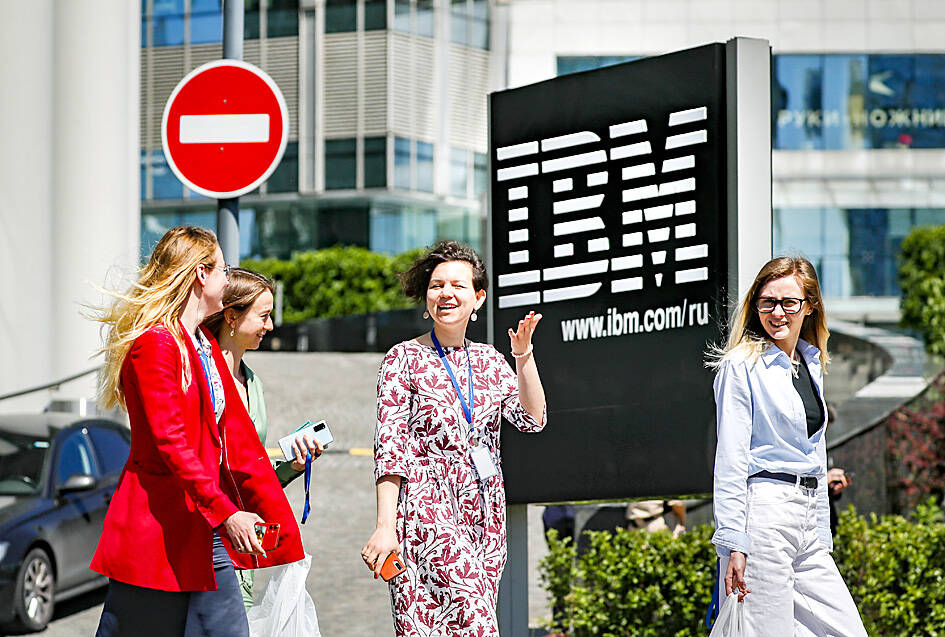International Business Machines Corp (IBM) dropped from the top spot for US patents last year, the first time in decades that the company has not claimed the most patents in a year, signaling a strategy shift at the long-time intellectual property leader.
IBM’s patent count declined 44 percent to 4,743, falling to No. 2 behind Samsung Electronics Co’s 8,513, Harrity LLP’s Patent 300 list showed.
Technologies such as semiconductors and hardware memory saw the largest drop in IBM patents, although the reduction was across all major types.

Photo: EPA-EFE
The decline reflects a strategy shift that began in 2020 to focus the patent portfolio on IBM’s core businesses and free engineers from the time-consuming patent process, IBM research head Dario Gil said in an interview.
“We decided to no longer pursue numeric patent leadership, but remain an intellectual property powerhouse and continue to have one of the strongest portfolios in the world in our priority technologies,” he said.
The Armonk, New York-based company has long prided itself on patent leadership, saying it had the highest number of filings for the past 29 years.
Intellectual property licensing and development has also been lucrative.
IBM has generated more than US$27 billion in income from patents since 1996, company filings showed.
However, that money has in the past few years slowed down as some companies have resisted licensing fees.
However, IBM is not done monetizing its intellectual property, Gil said.
“On the priority areas — hybrid cloud, AI [artificial intelligence], semiconductors, cybersecurity, quantum — we will continue to patent and defend that aggressively,” Gil added.
The shift mirrors IBM’s broader transformation away from hardware and legacy infrastructure toward cloud services and software.
Under IBM CEO Arvind Krishna, the company has made more than 25 acquisitions since April 2020, including AI software powerhouse Red Hat Inc.
IBM in November 2021 spun off a large portion of its infrastructure services business into a company called Kyndryl Holdings Inc.
The spinoff was not a reason for the patent decline last year, Gil said.
IBM has been a relative haven in the tech market meltdown, rallying 5.4 percent last year, compared with a 33 percent dip in the NASDAQ 100.
In the most recent earnings report, the company beat sales estimates and affirmed its cash flow forecast.
SAMSUNG, CHINESE FIRMS
Samsung has long been the runner-up before last year, being issued more than 8,000 new patents a year since 2017, Harrity’s list showed.
It was often awarded patents on visual display systems and voice communication.
Chinese technology firms such as TikTok parent ByteDance Ltd (字節跳動) and Internet firm Baidu Inc (百度) saw some of the steepest increases in patent issuance on the list.
For example, ByteDance has applied for a patent on a method of adding special effects to human bodies on video, commonly used in TikTok filters.
Tencent Holdings Ltd (騰訊) and Alibaba Group Holding Ltd (阿里巴巴) also saw large increases.
“Patent filings in China have been exploding for years,” Harrity analytics chief Rocky Berndsen said. “So as more of these companies do business in the US, we would expect the numbers to increase here as well.”

CHIP RACE: Three years of overbroad export controls drove foreign competitors to pursue their own AI chips, and ‘cost US taxpayers billions of dollars,’ Nvidia said China has figured out the US strategy for allowing it to buy Nvidia Corp’s H200s and is rejecting the artificial intelligence (AI) chip in favor of domestically developed semiconductors, White House AI adviser David Sacks said, citing news reports. US President Donald Trump on Monday said that he would allow shipments of Nvidia’s H200 chips to China, part of an administration effort backed by Sacks to challenge Chinese tech champions such as Huawei Technologies Co (華為) by bringing US competition to their home market. On Friday, Sacks signaled that he was uncertain about whether that approach would work. “They’re rejecting our chips,” Sacks

NATIONAL SECURITY: Intel’s testing of ACM tools despite US government control ‘highlights egregious gaps in US technology protection policies,’ a former official said Chipmaker Intel Corp has tested chipmaking tools this year from a toolmaker with deep roots in China and two overseas units that were targeted by US sanctions, according to two sources with direct knowledge of the matter. Intel, which fended off calls for its CEO’s resignation from US President Donald Trump in August over his alleged ties to China, got the tools from ACM Research Inc, a Fremont, California-based producer of chipmaking equipment. Two of ACM’s units, based in Shanghai and South Korea, were among a number of firms barred last year from receiving US technology over claims they have

OPTION: Uber said it could provide higher pay for batch trips, if incentives for batching is not removed entirely, as the latter would force it to pass on the costs to consumers Uber Technologies Inc yesterday warned that proposed restrictions on batching orders and minimum wages could prompt a NT$20 delivery fee increase in Taiwan, as lower efficiency would drive up costs. Uber CEO Dara Khosrowshahi made the remarks yesterday during his visit to Taiwan. He is on a multileg trip to the region, which includes stops in South Korea and Japan. His visit coincided the release last month of the Ministry of Labor’s draft bill on the delivery sector, which aims to safeguard delivery workers’ rights and improve their welfare. The ministry set the minimum pay for local food delivery drivers at

It is challenging to build infrastructure in much of Europe. Constrained budgets and polarized politics tend to undermine long-term projects, forcing officials to react to emergencies rather than plan for the future. Not in Austria. Today, the country is to officially open its Koralmbahn tunnel, the 5.9 billion euro (US$6.9 billion) centerpiece of a groundbreaking new railway that will eventually run from Poland’s Baltic coast to the Adriatic Sea, transforming travel within Austria and positioning the Alpine nation at the forefront of logistics in Europe. “It is Austria’s biggest socio-economic experiment in over a century,” said Eric Kirschner, an economist at Graz-based Joanneum